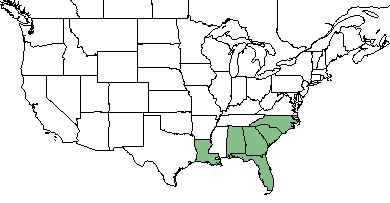Difference between revisions of "Rhynchospora odorata"
(→Ecology) |
(→Ecology) |
||
| Line 36: | Line 36: | ||
<!--===Seed dispersal===--> | <!--===Seed dispersal===--> | ||
<!--===Seed bank and germination===--> | <!--===Seed bank and germination===--> | ||
| − | + | ||
| + | ===Fire ecology=== <!--Fire tolerance, fire dependence, adaptive fire responses--> | ||
| + | Populations of ''Rhynchospora odorata'' have been known to persist through repeated annual burning.<ref>Platt, W.J., R. Carter, G. Nelson, W. Baker, S. Hermann, J. Kane, L. Anderson, M. Smith, K. Robertson. 2021. Unpublished species list of Wade Tract old-growth longleaf pine savanna, Thomasville, Georgia.</ref> | ||
<!--===Pollination and use by animals===--> | <!--===Pollination and use by animals===--> | ||
<!--==Diseases and parasites==--> | <!--==Diseases and parasites==--> | ||
Revision as of 21:54, 27 July 2021
Common name: fragrant beaksedge [1]
| Rhynchospora odorata | |
|---|---|

| |
| Photo by John Gwaltney hosted at Southeastern Flora.com | |
| Scientific classification | |
| Kingdom: | Plantae |
| Division: | Magnoliophyta - Flowering plants |
| Class: | Liliopsida - Moncots |
| Order: | Poales |
| Family: | Cyperaceae |
| Genus: | Rhynchospora |
| Species: | R. odorata |
| Binomial name | |
| Rhynchospora odorata C. Wright ex Griseb. | |

| |
| Natural range of Rhynchospora odorata from USDA NRCS Plants Database. | |
Contents
Taxonomic Notes
Synonym: R. stipitata (Chapman)
Variety: none
Description
R. odorata is a perennial graminoid of the Cyperaceae family that is native to North America.[2]
Distribution
R. odorata is commonly found in the southeastern United States; specifically Florida, Georgia, South Carolina, North Carolina, Alabama, and Louisiana.[2]
Ecology
Habitat
R. odorata proliferates in maritime swamp forests and maritime wet grasslands.[1] Specimens have been collected from dry sands, burned palmetto slashpine flatwoods, brackish marsh, moist roadside, willow thicket, pineland, swampy woodland, pine flatwoods, sand loam in hammock, mesic flatwoods, and in coastal hammock.[3]
Fire ecology
Populations of Rhynchospora odorata have been known to persist through repeated annual burning.[4]
Conservation, cultivation, and restoration
Cultural use
Photo Gallery
References and notes
- ↑ 1.0 1.1 Weakley, A. S. (2015). Flora of the Southern and Mid-Atlantic States. Chapel Hill, NC, University of North Carolina Herbarium.
- ↑ 2.0 2.1 USDA Plant Database
- ↑ URL: http://herbarium.bio.fsu.edu. Last accessed: June 2018. Collectors: Loran C. Anderson, Leo L. Minasian Jr., R.K. Godfrey, C. Jackson, Robert Kral, Mabel Kral, Richard S. Mitchell, K. Craddock Burks, William Lindsey, D.B. Ward, D. Burch, J.N. Triplett, Delzie Demaree, Steve Orzell, E. L. Bridges, O Lakela, William R. Stimson, A. H. Curtiss. States and counties: Florida (Wakulla, Franklin, Levy, Dixie, Collier, Volusia, Sumter, Pasco, Jefferson, Nassau, Monroe, Hernando, Gulf, Dade, Clay, Charlotte, Citrus, Broward, Brevard, Marion)
- ↑ Platt, W.J., R. Carter, G. Nelson, W. Baker, S. Hermann, J. Kane, L. Anderson, M. Smith, K. Robertson. 2021. Unpublished species list of Wade Tract old-growth longleaf pine savanna, Thomasville, Georgia.